Starry Night 7 simulation of NASA Rosetta Probe encounter with Churyomov-Gerasimenko (67P) - model is using NASA data current to Sept 8th 2014
Perseid Meteors vs. the Supermoon
The Perseids can usually be relied on to put on a good performance. But this year, observers beware! At their best just after midnight on the night of August 12/13, they will have the interference from a bright, nearly full "Supermoon" to contend with. Dress warmly, lie back on a deck chair, and enjoy the show.
Rosetta spacecraft reaches comet and makes history
"Thruster burn complete. Rosetta has arrived at comet 67P. We're in orbit!" ~ NASA
Rosetta spacecraft reaches comet and makes history!
Download Starry Night 7 Rosetta-67P SNF files here:
https://drive.google.com/…/0B4R9PVVyKIqyRTNBbEFmcDhQW…/edit…
Europe’s Rosetta spacecraft arrived at comet 67P/Churyumov–Gerasimenko today after a ten year journey, making history by becoming the first spacecraft to orbit a comet. It will now look for an appropriate landing site for its Philae lander, scheduled to land in November.
Double Stars around Boötes
On a May evening many years ago, I made my first exploration of the night sky. The only star pattern I could recognize was the Big Dipper, but with a star chart in a book, I used that to discover the bright star Arcturus in the constellation Boötes.
The curve of the Big Dipper's handle leads to Arcturus, the brightest star in the kite-shaped constellation of Boötes. Surrounding Boötes is an amazing variety of double stars. Credit: Starry Night software
The trick to learning the constellations is to begin with the stars you know, and use them to identify their neighbors. This same technique, known as "starhopping" is the key to discovering all the wonders hidden amongst the stars.
Start, as I did, with the Big Dipper, high overhead as the sky gets dark at this time of year. The stars that form the Dipper’s handle fall in a gentle arc, and if you project that arc away from the Dipper’s bowl, you come to a bright star. This is Arcturus, the third brightest star in the night sky, and the brightest star in the northern sky. Only Sirius and Canopus, far to the south, are brighter.
Arcturus is bright in our sky for two reasons, first because it is relatively close to us, 38 light years away, and secondly because it is inherently a bright star, much brighter than our Sun. Though larger and brighter, it is a slightly cooler star than our Sun, so appears orange to our eyes.
Although Boötes is supposed to be a ploughman in mythology, its pattern of stars most resembles a kite, with Arcturus marking the bottom of the kite where the tail attaches. Notice the little dots over the second "o" in Boötes: this indicates that the two "o"s are supposed to be pronounced separately, as "bow-oo’-tees," not "boo’-tees."
Once you have identified Boötes, you can use its stars to identify a number of constellations surrounding it. Between it and the Big Dipper are two small constellations, Canes Venatici (the hunting dogs) and Coma Berenices (Bernice's hair). To Boötes left (towards the eastern horizon) is the distinctive keystone of Hercules. Between Hercules and Boötes is Corona Borealis (the northern crown) with Serpens Caput, the head of the serpent, poking up from the south.
Although most stars appear to our unaided eyes as single points of light, anyone with access to binoculars or a telescope soon discovers that nearly half the stars in the sky are either double or multiple stars. Some of these are just accidents of perspective, one star happening to appear in the same line of sight as another, but many are true binary stars: two stars in orbit around each other, similar to the stars which shine on the fictional planet Tatooine in Star Wars.
Every star labeled on this map of Hercules, Boötes, and Ursa Major is a double star, worth exploring with a small telescope. Some, like Mizar in the Dipper’s handle, can be split with the naked eye. A closer look with a telescope shows that this is really a triple star. Others require binoculars or a small telescope. Some of the finest are Cor Caroli in Canes Venatici, Izar (Epsilon) in Boötes, Delta Serpentis, and Rho Herculis.
One of the joys of double star observing is the colour contrasts in some pairs. Others are striking for matching colours and brightness. My favorites are stars of very unequal brightness, which look almost like stars with accompanying planets.
Also marked on this chart are three of the finest deep sky objects: the globular clusters Messier 13 in Hercules and Messier 3 in Canes Venatici, and the Whirlpool Galaxy, Messier 51, tucked just under the end of the Big Dipper’s handle. You will probably need to travel to a dark sky site to spot this galaxy. A six-inch or larger telescope will begin to reveal its spiral arms, including the one that stretches out to its satellite galaxy, NGC 5195.
Starry Night 7: High Resolution Planetary Texture Collection
In recent years, NASA has conducted numerous exploratory missions that provided detailed measurements of the visual appearance and physical characteristics of most of the planets and moons in our solar system. These categories include IR/UV/visible imagery, physical, chemical and geological properties of the celestial bodies.
Measurements range from surface features to physical properties to chemical and geological characteristics. Surface features consist of topography, albedo, roughness and age. Fundamental physical properties include gravity, magnetism and temperature. Chemical and geological quantities comprise elemental composition, mineral distributions, geological maps and crustal thickness.
Starry Night Pro Plus 7 offers a Planetary Science Texture Compilation with over 100 additional maps. Planetary images and data were derived from the latest datasets available. The original, highest quality sources were used to produce maps with maximum fidelity. Gaps and artifacts in individual datasets were corrected with data from older or alternate sources obtained by other exploratory space missions to produce consistent, high quality images that clearly illustrate the parameters of interest.
Earth:
Light Pollution Atlas
Jupiter:
Callisto Color
Callisto Gray
Europa Color
Europa Gray
Ganymede Color
Ganymede Gray
Io Color
Io Geology
Io Gray
Jupiter Color
Shoemaker-Levy
Mars:
Mars Albedo Color
Mars Albedo Gray
Mars Elemental Abundance Set
Mars Geoid
Mars Geological Map
Mars Gravity
Mars Magnetic Field
Mars MDIM
Mars Roughness
Mars Surface Dust Index
Mars Thermal Inertia
Mars Topo Jade
Mars Topo Spectrum
Mars Viking Color
Mars Viking MDIM Merged
Mars Viking Shaded
MOC color
MOC gray
Mercury:
Messenger Color
Messenger Gray
Mercury Messenger Color
Mercury Messenger Gray
Moon:
Clementine Color
Clementine False Color
Clementine Gray
Clementine Iron
Clementine Mineral Ratio
Clementine Optical Maturity
Lunar Gravity
Moon Crustal Thickness
Moon Elemental Abundance Set
Moon Geoid
Moon LROC Gray
Moon Roughness
Moon Temperature
Moon Topo
Moon Illusion Beetle
Moon Illusion Lady
Moon Illusion Lady Reading Book
Moon Illusion Man In Moon
Moon Illusion Rabbit
Moon Illusion St. George
Saturn:
Dione Gray
Enceladus Color
Enceladus Gray
Iapetus Color
Iapetus Gray
Mimas Gray
Phoebe Gray
Rhea Gray
Saturn Bjorn Jonsson
Saturn Hubble
Tethys Gray
Titan Color
Titan Gray
Titan IR
Titan Lakes
Titan Topo
Titan Topo scale
Sun:
Ca II 3933A
FeIX-FeX 171A
FeIX-FeX 171APNG Tiles
FeVII 195A
H-alpha
He II 304A
Venus:
Venus Geoid
Venus Gravity
Venus Magellan Color
Venus Magellan Gray
Venus Topo
Vesta:
Vesta Gray
Vesta Rock Types
Vesta Topo
Starry Night 7: Stars Rendered as 3D Bodies
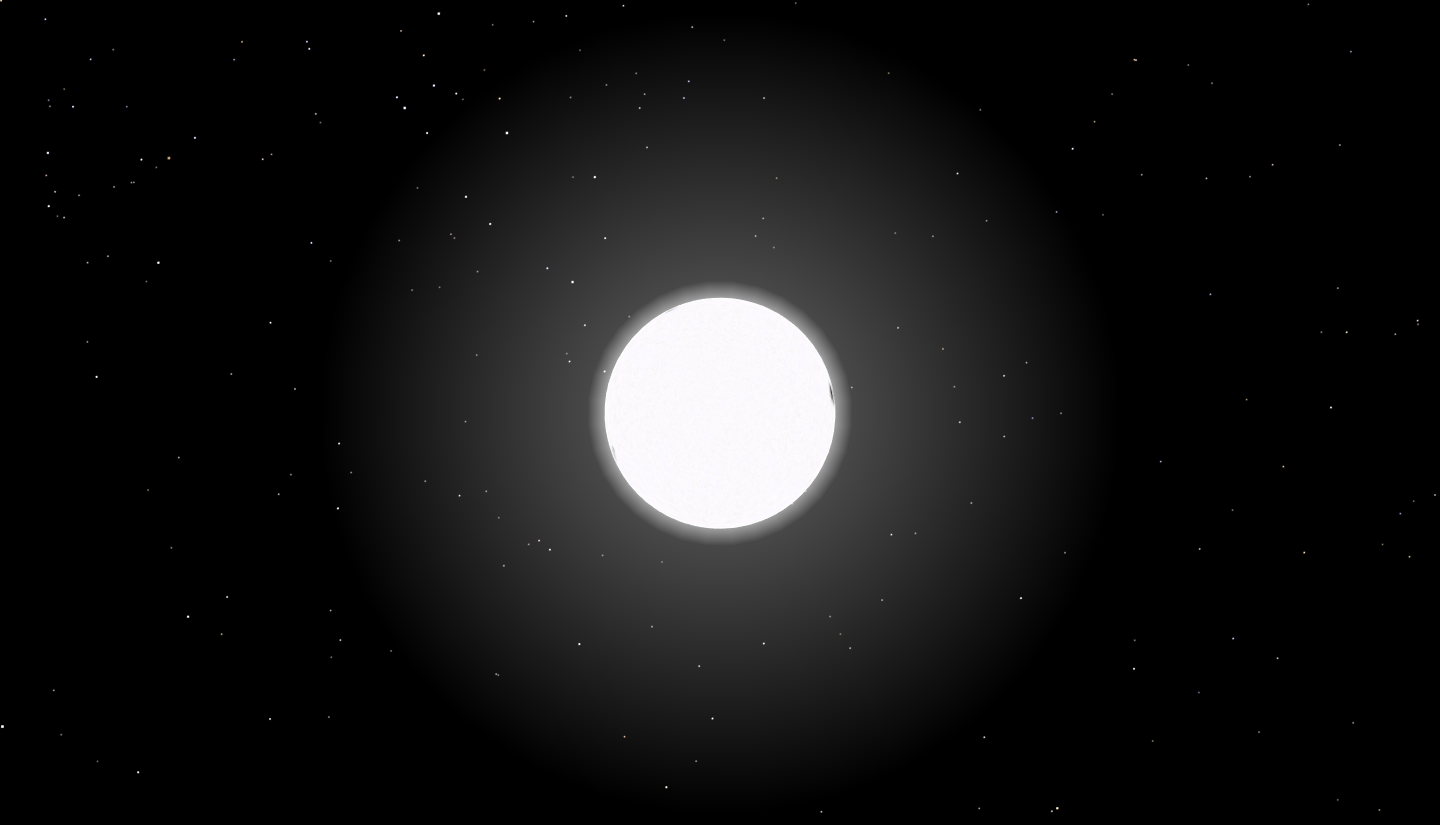
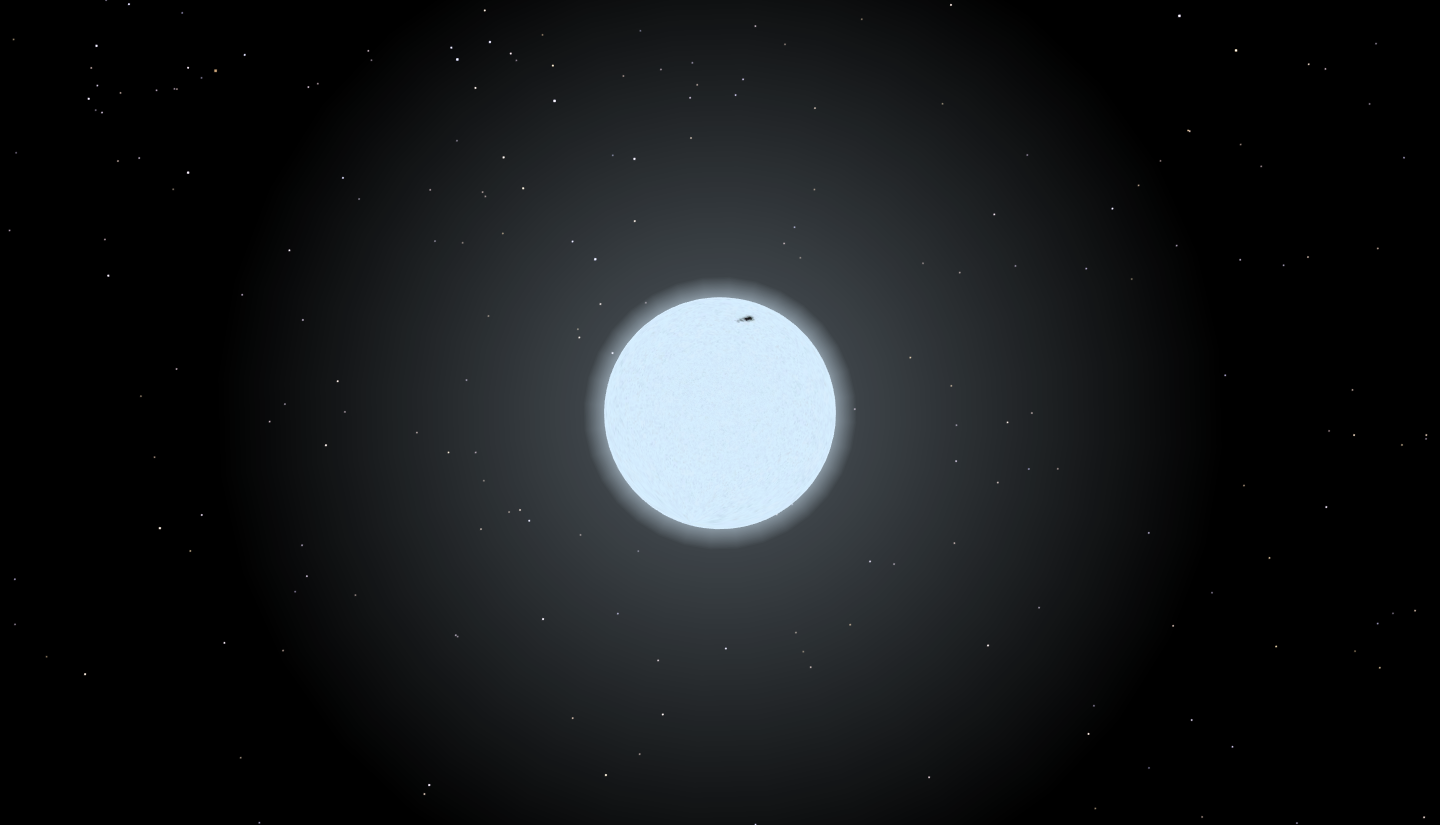
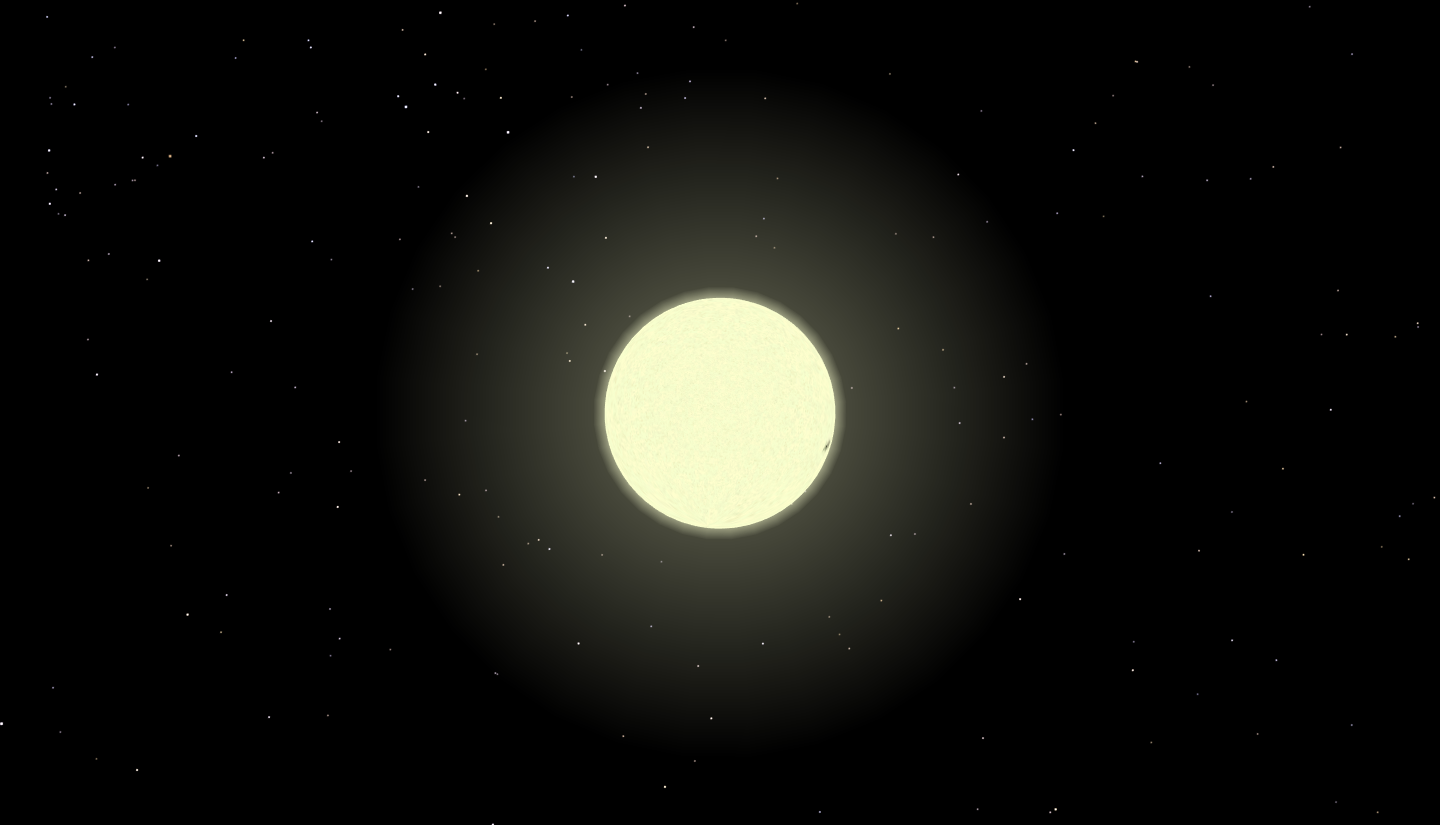
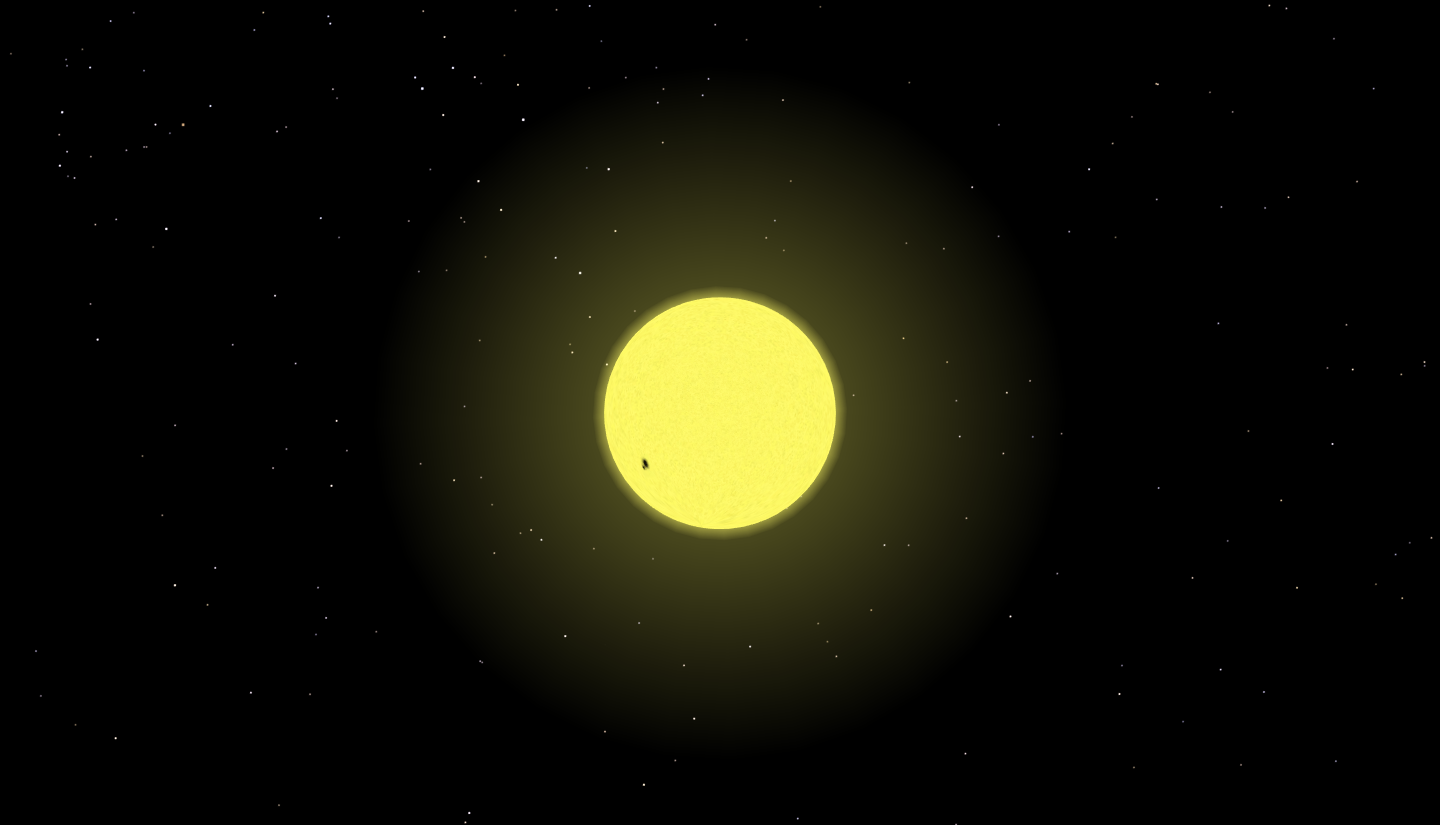
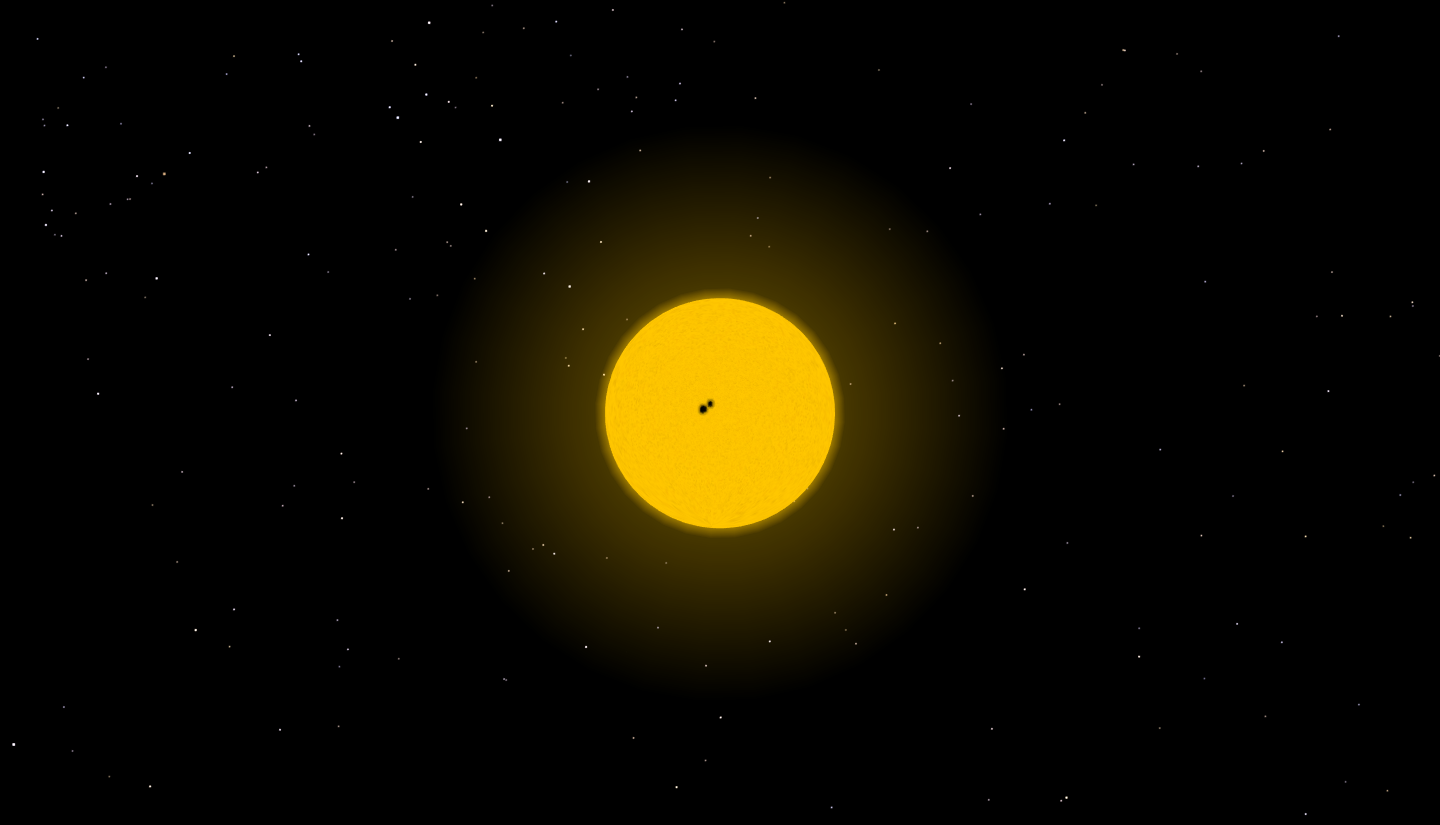
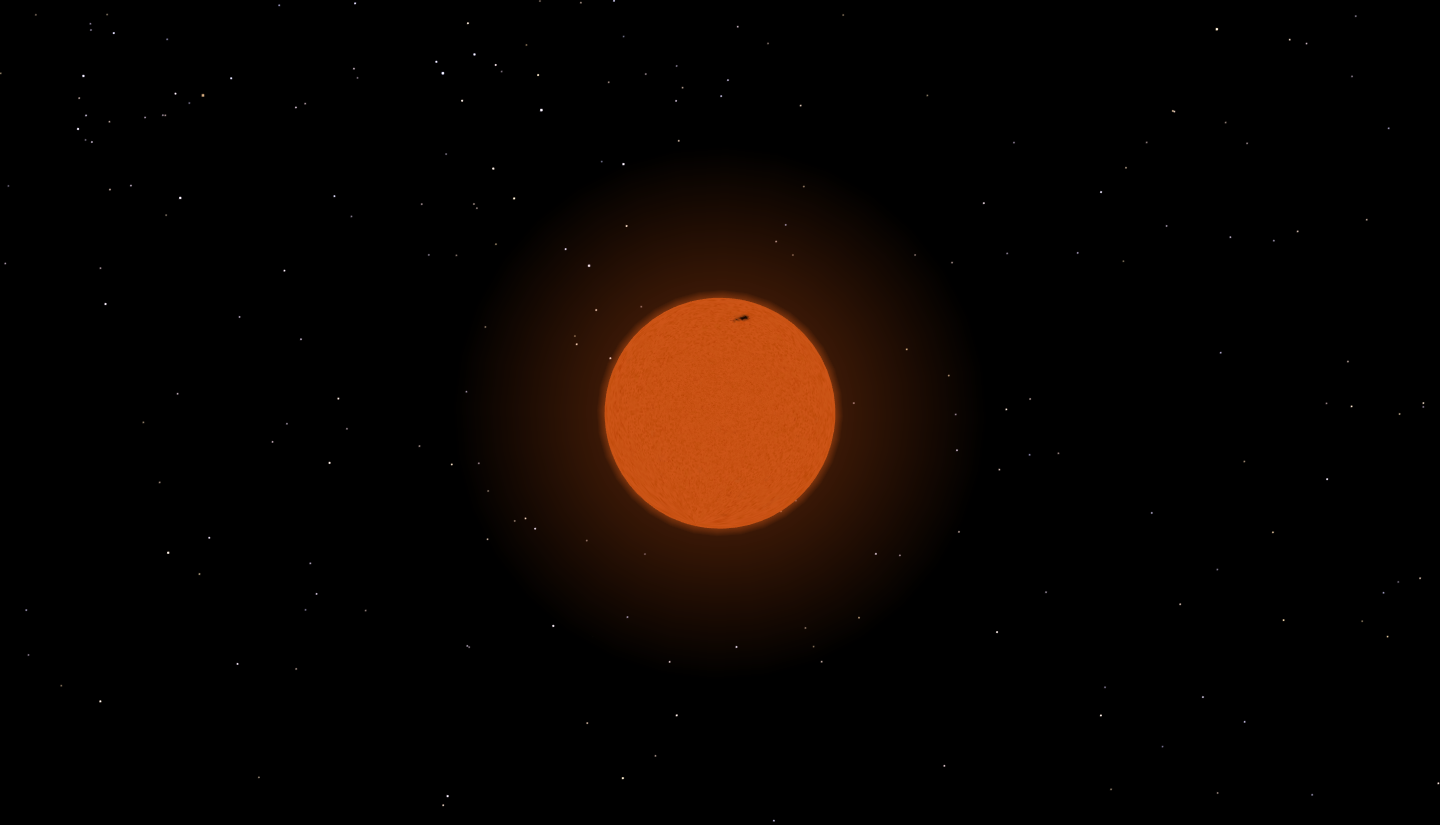
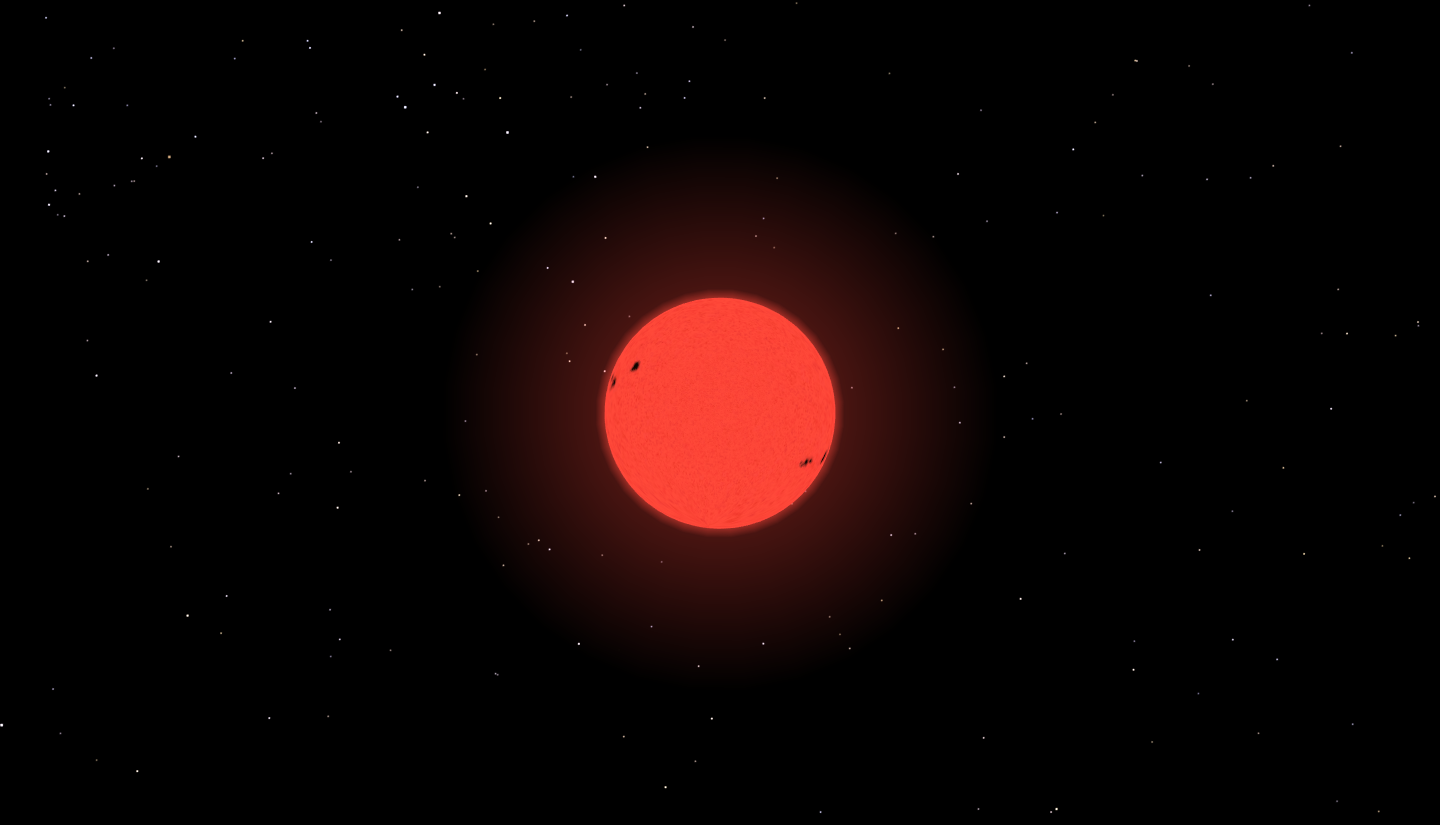
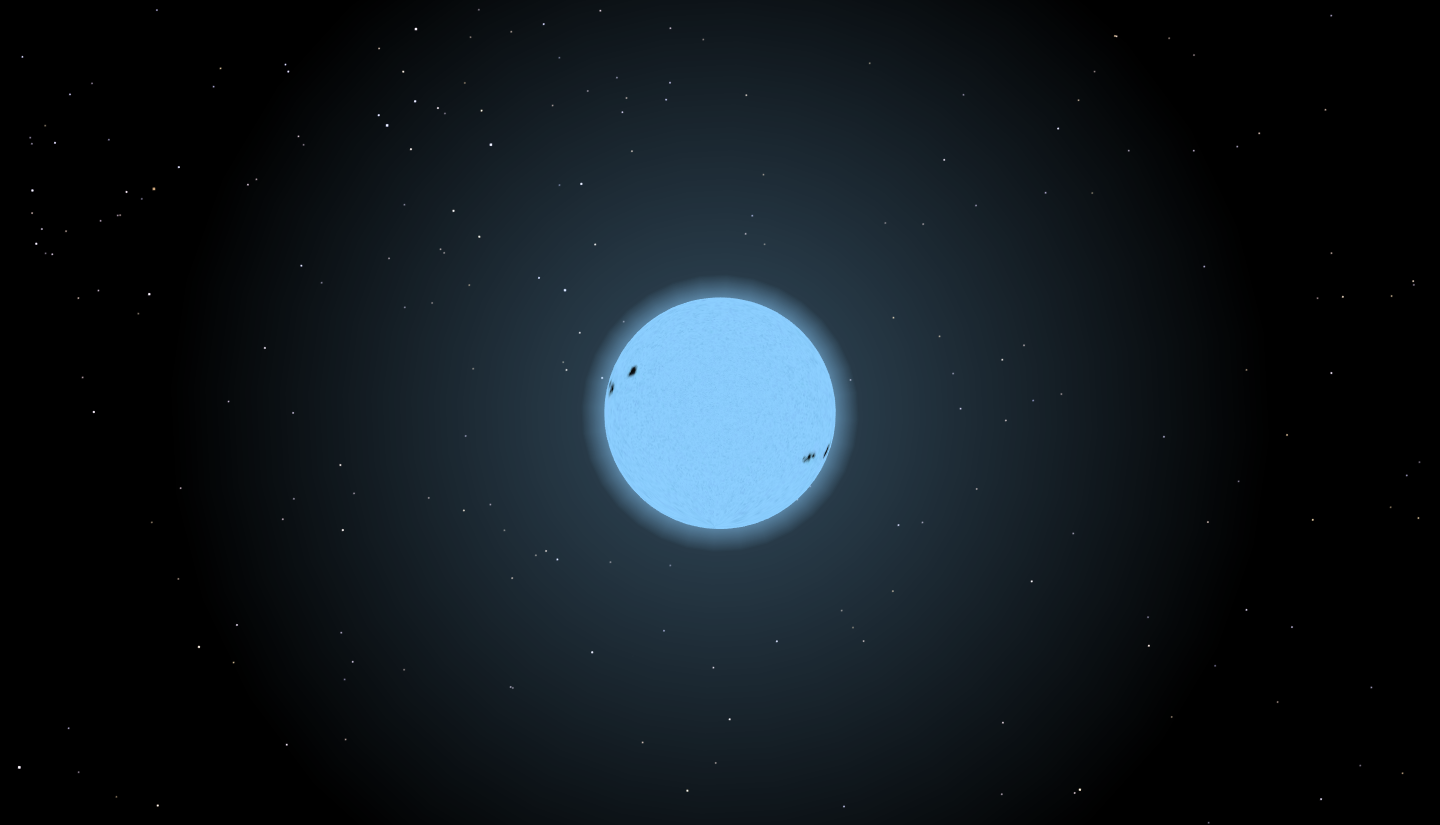
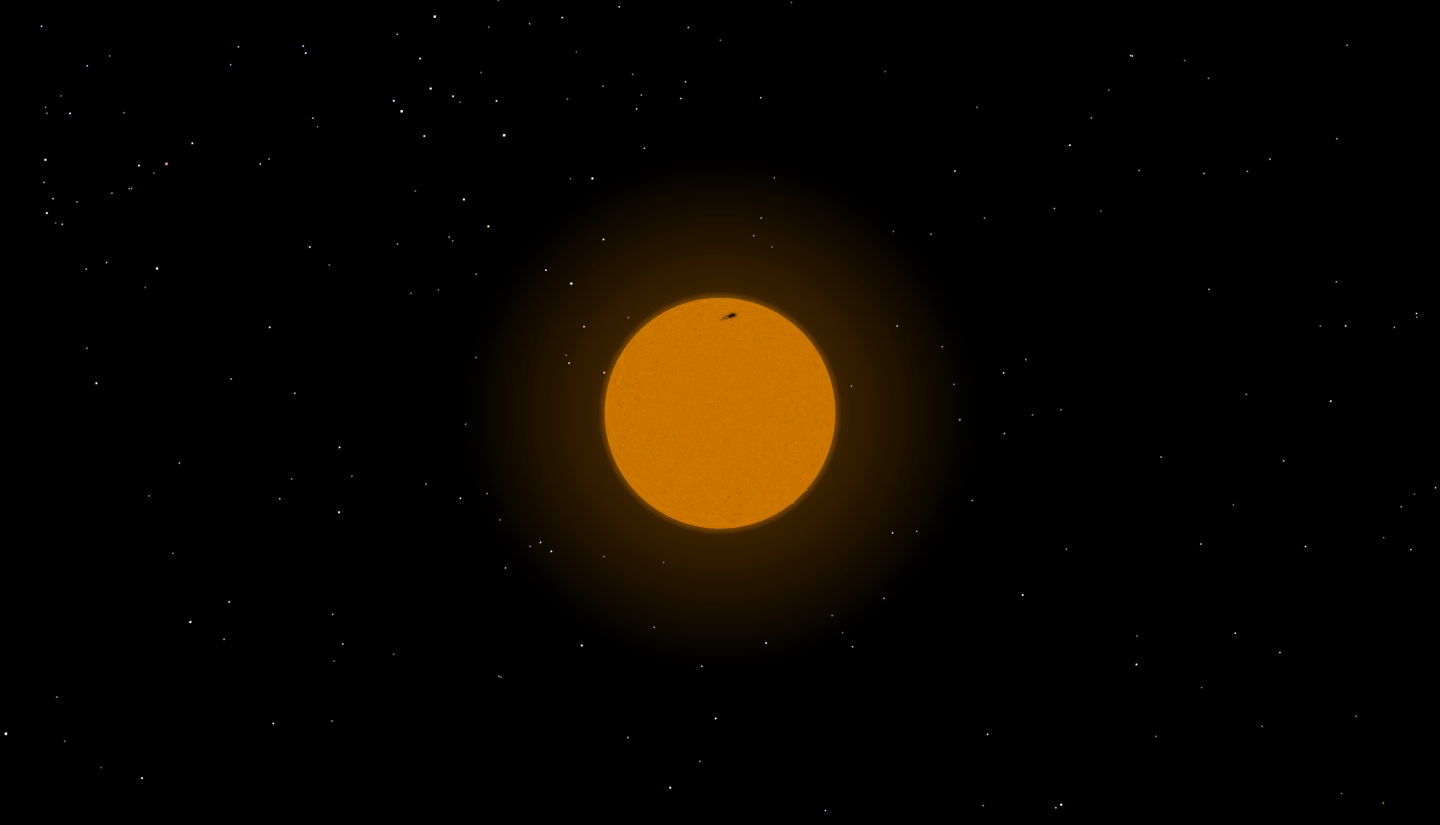
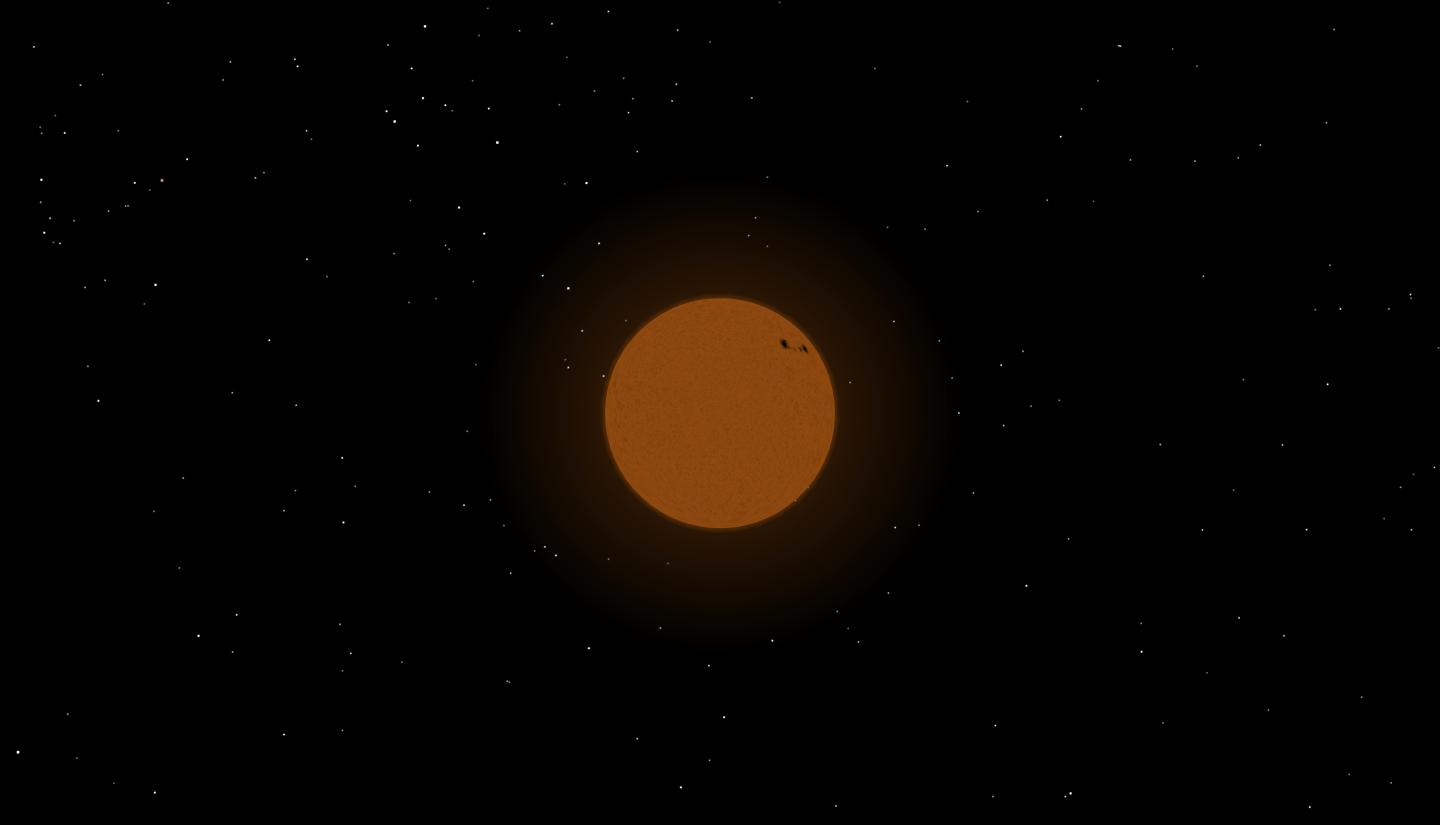
One of the many exciting new features in Starry Night 7, is the ability to accurately render stars as 3-dimensional bodies with classification appropriate color, texture and relative radii.
A star is any body which burns or once burned hydrogen fuel. The energy and light produced in stars comes from the fusion of hydrogen atoms. As stars grow older, they use up their supply of hydrogen and have to find other sources of energy. When they reach this point, they become either red giants or supergiants, depending on their size. As they continue to use up energy, stars eventually become either white dwarfs or, in the case of very massive stars, neutron stars or black holes.
The star database in Starry Night is actually a compilation of several databases: the Hipparcos catalog, the Tycho-2 catalog, and Starry Night Pro and Pro Plus also include the USNO-A2 catalog.
The Hipparcos catalog comes from a European Space Agency project to determine the distance to our nearest stars. The 100,000 or so stars in this catalog are correctly plotted in 3D space and accurately displayed in Starry Night. This means you can leave the Earth behind and visit any of these stars. When you get there, the star will be rendered as a 3D body with the correct colour, texture and relative radii. It is as close to being there, without actually being there.
You can find out more about the Hipparcos catalog on the official web page:
http://www.rssd.esa.int/index.php?project=HIPPARCOS
Classification-Appropriate Color
Stars can be classified based on their spectral characteristics. This is done by splitting light with a prism or diffraction grating into a spectrum of colors and absorption lines. Absorption lines (dark lines or lines of reduced intensity on a continuos spectrum) are used as ‘fingerprints’ to help identify the relative abundance of different ions, which vary with the temperature of a star’s photosphere.
In short, the absorption lines present in a stars spectra allow us to classify stars into several spectral classes depending on the temperature of the star. And in general, a star’s temperature determines its color.
The scheme we use is the Harvard Spectral Classification Scheme, originally developed in the late 1800’s at the Harvard college observatory.
The scheme uses single letters of the alphabet to group stars according to their spectral features. Stars were assigned a spectral class letter based on the strength of the hydrogen absorption lines in their spectra. The main spectral classes are OBAFGKMLTY. This sequence is ordered from the hottest to the coolest stars. Using this scheme, our Sun, the nearest star to Earth, is a class G star.
There are two main methods to describe the color of a star based on spectral class. In Starry Night 7, we use theconventional colour description in the table above to represent spectral class colors. The conventional color description is what would be seen if the star were put under high magnification and projected onto a white sheet of paper in the daylight (takes into account only the peak of the stellar spectrum). Using this color description, our Sun appears yellow.
However, the actual apparent color description is what would be seen by the human eye under a dark sky. Using this color description, our Sun appears yellowish white.
A future update to Starry Night, will allow you to select between conventional color and apparent color to represent the spectral class of a star.
Texture
Each 3D rendered star displays a high resolution texture with detailed sunspots and granulated features, based on spectral class. We tried to make each star as unique as possible.
Relative Radii
All 3D stars in Starry Night 7 are rendered with their correct radii. To show the relative sizes of different stars, Starry Night places you at 0.023 Astronomical Units (AU) from a stars center when you select the Go There command. This means that a red giant star will appear large on your screen and a white dwarf star will look very small.
Luminosity
Besides the star surface itself looking more like it is emitting light rather than reflecting light like a planet does, we render simple atmospheres around the star. Each star has a "lower" and "higher" atmosphere. The lower atmosphere typically extends no more than 0.1 radii from the star and gives a softer-looking edge. The higher atmosphere typically extends multiple radii away from the planet and provides the overall haze effect within the vicinity of the star.
Based on the stellar class, we try to convey a sense of luminosity by varying the atmosphere sizes.
Star Horizon Panoramas
In addition to orbiting a 3D star, you can also land on its surface via the Go There Surface command. Each star has a unique horizon panorama to match it’s spectral class.
The Future
As part of the ongoing development of version 7, we plan on continuing to improve the appearance, accuracy, information and features available for discovering, viewing and exploring 3D stars. How neat would it be to view double stars in 3D, see the inside layers of a red giant, display a stars habitable zone or even animate solar flares? Stay tuned…
Development (and Beta Testing) Never Ends
Software development sometimes entails hardware development too!
There were (for us) many firsts with the release of Starry Night Pro Plus 7. Exoplanets, data streaming, in-application updates, automatic crash reports - to name just a few. The scope of these new facilities and modernization of the old ones required tons of development time on the app itself. In addition, a lot of development had to be done on our servers too, a topic of a future article.
There is, however, one other area which has required many hours of development and use of a large number of technologies, most of them necessary to automate the process. This component is now integral to the lifecycle of SN7 and any future versions of our desktop applications. It assures that problems are caught early and that updates are tested before everyone gets them. I am talking about our Starry Night Beta program.
Mentioning beta testing evokes notions of release candidates, fixed release schedules and long delays between changes in the beta code and their eventual release to the public. We, of course, do our best to adhere to the wisdom of desktop beta testing. However, we also wanted Starry Night Beta to be more agile, and, above all, always alive.
Among other things, with the new automatic crash reporting and streamlined workflow of dealing with bug reports and user submitted support tickets, we wanted SN7 development to be as responsive to our users as we can make it. We scrutinize every crash report and investigate every bug report. We try and catch problems early. And we want to get relevant improvements and fixes into the software as soon as possible. This is what drove our implementation of in-app updates. And this is what drives our efforts in keeping Starry Night Beta going, even after SN7 has been released - because updates need testing too!
There are many arms to the beta (sometimes also referred to as "nightly") builds of SN7 and the systems used to get changes as quickly as possible into the hands of our testers. Here they are in their raw, technical jargon. All of the following tasks are fully automated, set in a sequence, and alert the developers of any problems encountered along the way.
- Mac: checkout from the relevant branch of SN7 git repository
- Windows: checkout from the relevant branch of SN7 git repository
- Mac: build SN7
- Mac: checkout from the relevant branch of Sky Data git repository
- Mac: pool all the data for Pro Plus into the new Sky Data folder
- Mac: add in the Manual and User guide to the final application
- Mac: checkout from the relevant branch of AllSkyImage git repository
- Mac: add all the AllSkyImage data that needs to be bundled into Pro Plus final app
- Mac: build the latest Mac telescope plugin and add it to the application
- Mac: codesign the final application bundle (to satisfy Gatekeeper)
- Mac: store the freshly built app until relevant build number in our application storage
- Mac: construct a pkg installer of the application
- Mac: build a DMG disk image for the pkg installer to make the installation clearer and easier
- Fire up a very large AWS EC2 instance that is used to quickly compress Windows installation data
- Mac: rsync final application to the EC2 instance
- Mac: create a drag-install DMG on Linux using genisoimage and libdmg-hfsplus
- Mac: push built dmg to S3 for (full) updates
- Mac: push the new build number to the relevant branch of SN7 git repository
- Mac: package and push the new symbols file of our application to HockeyApp - the service we use to receive crash reports
- Mac: read the relevant build release notes, if any, from our SN7 git repository, otherwise use current date stamp as a comment for the beta release
- Mac: add details about the freshly built application to our release database (size, build number, version number, location of DMG file)
- Mac: retrieve all active beta builds from the database
- Mac: go through each previous version and create a delta update between the current and specific previous version (using BinaryDelta from Sparkle project)
- Mac: for each delta update created, make an entry in our database with information about the update, size, versions involved
- Mac: push each delta update to S3 for distribution
- Windows: start a Windows instance on Parallels (we automate Windows building by invoking tasks from Mac to our virtual machine on Parallels)
- Windows: build and sign SN7
- Windows: copy Manual and User guide to the app
- Windows: create a new full build of Windows for local app archive. Use already built Sky Data from our constructed Mac app.
- Windows: build and add in relevant Windows plugins (telescope, focuser, MaxIm DL)
- Windows: format release notes so that they can be used in automated xml-powered update building process with wyBuild
- Windows: prepare specifications for delta update building by writing out an xml file with the latest information
- Windows: build all delta updates using wyBuild. Let wyBuild upload all the data to our S3 server for distribution.
- Windows: take the newly created wyUpdate.exe and client.wyc and put them into a folder used to assemble our Windows installer
- Windows: push the additions to our wyBuild project and new wyUpdate.exe, client.wyc and wyserver.wys files to the relevant branch of SN7 git repository
- Windows: launch and build our installer by invoking Advanced Installer on our aip project file (this only builds the minimal setup)
- Windows: package and push the new symbols file of our application to HockeyApp
- Windows: push the built installer to our EC2 instance
- Windows: launch 7z compression separately on AllSkyImage and Sky Data on EC2 instance
- Windows: using winrar on Linux, compress the installer, additional data 7z archives and custom modified SFX file header into Self-Extracting single exe
- Windows: sign the installer exe with signcode (from github.com/mono project) on Linux to conform with Microsoft Authenticode
- Windows: copy the built single-exe installer to S3 for distribution
- Windows: shutdown the Parallels VM
- Shutdown the EC2 instance
- Mac: copy the built pkg-based dmg installer to S3 for distribution (this is currently the slowest part of the process which is why it is last)
Finally, on the distribution chain, we keep things separate between public releases and Starry Night Beta. Applications built for public release are essentially different builds (which is why beta versions and release versions will never again have the same build numbers). Beta builds only get beta updates. The same rule applies for public releases. On Mac, our appcast server reads different entries from our release database (to which information is added during the above build steps). On Windows we keep separate wyserver.wys and wyBuild projects - one for public releases and one for beta.
And this is just the nightly automated script for a single application (Pro Plus 7)! There is still a lot to be done to improve this system, parallelize some processes and implement failover solutions for others. We are currently using Parallels VM in order to easily script everything directly from one source. However, a Parallels VM could be replaced with another EC2 (Windows) instance. We want to keep the nightly builds no matter what and to make them faster and more robust! Even beta needs testing and development (a beta for Starry Night Beta?).
Until next time! Clear skies!
Starry Night 7: Streaming Data On-Demand
Starry Night Pro Plus 6, when fully installed, occupied more than 10GBs of disk space. The sheer size of it required jumping through lots of technological hoops; from huge downloads to special DVDs, each with their own set of gotchas. This led to a lot of problems, all to deliver every last bit of data, much of which might never be accessed!
With the ever expanding volumes of interesting astronomical data available to the general public, as well as the near ubiquitous availability of high-speed internet access, Starry Night 7 was designed with a new mantra... deliver it on-demand!
Not wanting to sacrifice our tradition of beautifully simulating huge sets of astronomical data, we designed a new, robust system to stream the high-resolution, or rarely accessed data as its needed.
Not only do we now have the ability to deliver you, our users, essentially infinite amounts of astronomical data, but we can now deliver you ONLY that data which you want.
The system, at its base, is quite simple:
Zoom in on a particular piece of the sky, descend onto Mars, or choose one of dozens of available horizon panoramas and Starry Night checks your local hard disk for the necessary files. If they're found, they're loaded into the sky. If not, Starry Night makes a request to our servers to download the necessary data, streaming it to your computer where it will remain for the next time you need it.
This was done in a very limited way in Starry Night 6... only very dim USNO stars were served up by this system.
We have since expanded on that (and will continue to expand on that) to include the AllSkyImage layer and dozens of high-resolution planet surface textures. Horizon Panoramas are next to come along with individual object data, and more and deeper databases.
Some 27 GBs of data rests on our servers, waiting to be streamed! Sit back, zoom in, and enjoy!
Starry Night 7.0.2 and Beyond
Development of Starry Night 7 is proceeding quickly, so I thought I'd take a sec to update everyone on what we're working on.
In the very short term, we'll release Starry Night 7.0.2, mostly to address crashes and other incompatibilities that weren't discovered during beta-testing. We're focusing on issues that make it difficult to use the app, and features that might be broken. I'm taking this week to true up the Equipment list too.
In the weeks to come, we're going to take a solid look at all of the feature requests, suggestions and comments all of you have made, as well as usability issues discovered by our Beta-Testers.
We'll be rewriting the Observation Logging feature, with a particular emphasis on sharing logs... with each other and with other applications. We'll be sure to enable importing of your V6 logs, not to worry!
In addition to improving all of the obvious observing features, we'll be looking at other ways to share experiences with your friends and co-observers, improve add-to and refine our databases, and improve the speed of the application.
Stick with us. Lots of interesting things to come.
How the stars are rendered
In Starry Night 7 all stars, such as Rigel shown here, are accurately rendered as 3-dimensional bodies with classification-appropriate color, texture and relative radii. You can even land on them!
Bringing Earth to life
Starry Night 7 brings the Earth to life! with advanced planet rendering including terrain shadows, ocean floor shading, specular reflections on water (light reflected from lakes and rivers), and city lights visible on the night side.
Importing SN6 data to SN7 (Or: How I learned to stop worrying and love Sky Data overrides.)
Because of the ubiquity of the internet, the vast volumes of data available to us (and therefore you, the SN user) and new security requirements imposed by operating systems, Starry Night 7 has introduced the idea of a "dynamic" (writeable) Sky Data folder.
In previous versions of SN, the application itself would edit (write to) files in its own Sky Data folder located either in the application package (on OSX) or in the Program Files folder (Windows) and this is now considered very bad behavior.
For that reason, any time SN needs to write/modify a file, we so in a new Sky Data folder located at:
(Windows) \Users\<YourUserName>\AppData\Local\Simulation Curriculum\Starry Night Prefs\
(Note that the AppData folder is often "hidden". A quick Googling can show you how to un-hide it)
(OS X) /Users/<YourUserName>/Library/Application Support/Simulation Curriculum/Starry Night Prefs/
Note that this is where any "streamed" data will be located too.
While we've made every effort to hide this ugliness from you the user, if for any reason you want to get your hands dirty and edit a file manually, it should first be copied to the same respective path (e.g. /Sky Data/Planet Images) in this new folder, then edited there.
Any file located in this new Sky Data folder should have the effect of overridding the one in our static Sky Data folder.
Now, for the part you've all been waiting for. How do you get all of your Equipment, Distance Spheres, Locations, Preferences, Custom (User) Planets etc. from SN6 to SN7?
Simply copy the individual files from your old "Prefs" folders into the matching locations in the new "Starry Night Prefs" folder!
Have fun!
Starry Night 7: Motivation, Process, Future
As many of you have noticed, we're back with a brand new version of Starry Night! Rather than list all of the cool new features, I thought I'd take a moment to make clear our motivations for the changes in SN, our process getting to where we are now, and plans for the future.
For many of our loyal, longstanding users, the new user interface is a big change from what they're used to. Our motivation for the change was simple: the interface had gotten to the point where users were spending more time looking at (or looking for!) controls, than looking at the sky. We needed something new, cleaner, less obtrusive.
In our redesign, we followed the general philosophy that the UI should "be there when you need it, disappear when you don't." The focus should always be on the sky view, never the controls. This for example, is why we moved the Find pane from the left to the right... in general, people read left-to-right. Left is more prominent, so the sky view should always be at the left.
Our move to a "Universal Search" function was similarly motivated.
We found that over the years, so many of the great new features that we had added were buried under layers of user interface, that not only were they hard to use, but people often never found them in the first place.
With the ability to do a textual search for control items (not just named objects in the night sky), we have opened up a host of existing features to users who didn't even know about them! No longer do you need to know exactly what setting you're looking for, open the Options panel, visually search for it, and click to make a change... simply search for the word (or even a related word) that you're looking for, and you'll probably find it.
While I think we have succeeded in many, many ways, we still have much work to do.
Going forward, we plan on continuing with the idea of "less is more." Not in terms of what you can do (indeed, we are addingfeatures and data) but in what ways you are distracted from what you are doing. Think: more of what you want, less of what you don't.
While we have released it into the wild, we're far from done with it. Starry Night 7 should be thought of as a journey, not a destination.
GJ 180 b and exoplanets
GJ 180 b is a warm superterran exoplanet 40 light-years away. It resides in the habitable zone around its parent star and has the potential to support surface life as we know it. Explore GJ 180 b and hundreds of other exoplanets in Starry Night Pro Plus 7!
GJ 180 b
Photos of Apollo missions
Houston's Lunar and Planetary Institute has made available almost 20,000 otherworldly images taken during Apollo missions (http://www.lpi.usra.edu/resources/apollo/catalog/70mm/ ). Dig deep and you'll find plenty of Instagrammable moments (eg. http://www.lpi.usra.edu/resources/apollo/frame/?AS16-116-18636 )
Can you match the photos with Apollo mission paths in Starry Night?
Orion and His Friends and Enemies
On winter evenings, the sky is filled with bright stars, more than at any other time of the year.
On winter evenings, Orion dominates the sky, surrounded by numerous striking constellations, all decorated with brilliant stars. Credit: Starry Night Software
Central in the southern sky is the constellation of Orion the Hunter. Along with the Big Dipper, this is probably the most easily recognized constellation, and the starting place for a stargazing adventure.
We apologize to our readers in the southern hemisphere, where it is summer. But even in the south, Orion dominates the sky right now. Turn the chart upside down, and everything we say will still apply.
Orion itself sits astride the celestial equator, half way between north and south celestial poles. This makes Orion an “equal opportunity” constellation, well seen everywhere on Earth except at the poles.
The main figure of Orion is a large rectangle of four bright stars, including two of the brightest stars in the sky, Betelgeuse at upper left and Rigel at bottom right. These four stars represent the shoulders and knees of a might hunter.
The thing that most people notice first is the diagonal line of bright stars right in the middle of the rectangle, which represent the giant’s belt, worn at a jaunty angle. Hanging from his belt are three stars representing his sword.
If you’re located at a dark sky site, you will be able to see more details in Orion. His rather small pointy head is represented by a triangle of stars. His right arm raises a club and his left arm raises something towards Taurus the Bull. Some legends have this as a lion’s skin, others as a shield.
I like to see Orion as a superhero beset by evildoers on all sides, but also with friends and allies.
Taurus, to his upper right, is marked by a bright red star, Aldebaran, in the midst of the cluster of stars known as the Hyades. A bit higher is a second cluster, the Pleiades. Both clusters are easily seen with the naked eye. Orion is shielding himself from the Bull with his lion’s skin.
Below Taurus, to the right of Orion, is a meandering stream of stars which early astronomers saw as the river Eridanus. This river meanders below the southern horizon for most people in the U.S.A., but those in southern Florida and Texas may catch a glimpse of its destination, the first magnitude star Achernar.
Above the horns of Taurus is Auriga the Charioteer, marked by Capella, the sixth brightest star in the night sky. I see him as the cavalry riding to Orion’s rescue.
Above and to the left of Orion is the constellation Gemini, the Twins, with its two bright stars Castor and Pollux. Currently this is where the planet Jupiter is located, outshining all the stars. So which is Castor and which is Pollux? I remember them because Castor is closest to Capella, both starting with a “C,” while Pollux is closest to Procyon, both starting with a “P.”
Orion, like all good hunters, is accompanied by his two hunting dogs, big and small: Canis Major and Canis Minor. “Canis” means “dog,” “major” means large, and “minor” means “small.”
Each dog contains one bright star: Procyon in Canis Minor and Sirius in Canis Major. There is only one brightish star besides Procyon in Canis Minor, making it more like a hot dog than a real dog. Canis Major is more like a real dog, sitting up with a head, body, and two hind feet. Sirius and Procyon are the first and eighth brightest stars in the night sky, and among the nearest to the sun at 8.6 and 11.4 light years distance respectively.
Between the two dogs is a faint constellation with a long name: Monoceros. “Mono” means “one” and “ceros” means “horn,” so Monoceros is a unicorn. Although it lacks any bright stars, it is one of the richest constellations in deep sky objects, because an arm of the Milky Way lies in this direction.
What is beneath Orion’s feet? Usually called Lepus the Hare, I like to think of this as Monty Python’s Killer Rabbit, yet another foe for our hero to vanquish.
Everything I’ve described can be seen with the unaided eye, even in fairly light polluted skies. If you have binoculars or a small telescope, there are incredible riches to be discovered, such as the clouds of glowing gas in Orion and Monoceros, the star clusters of Taurus, Auriga, Monoceros, and Canis Major, and the galaxies of Eridanus.
Venus Shines at its Brightest
This week Venus will be shining at its brightest, low in the southwestern sky just after sunset. Venus’ brightness is the result of geometry.
At 2 p.m. EST on Friday December 6, Venus will be shining at its brightest. Look for it in the southwestern sky just after sunset. Credit: Starry Night Software
As Venus moves around the Sun, closer to it than the Earth, we see it illuminated from all angles. This causes it to pass through a series of “phases” similar to the moon. When it is on the far side of the Sun, called “superior conjunction,” it is fully illuminated from our point of view, and we see it as a “full Venus.” It is 100 percent illuminated but far away, only 10 arc seconds in diameter.
When Venus is at “greatest elongation,” farthest from the Sun in our sky, as it was on November 1, we see it as a “half Venus.” When it passes between Earth and the sun, as it will on January 11 2014, called “inferior conjunction,” it is illuminated from behind, just like the new moon.
The brightness we see from Venus depends on two things: its phase and its distance from us. It should be brightest at its “full” phase, like the Moon, but at that time it is at its furthest from us. At “half” phase, as it was on November 1, only half of it is illuminated, but it is much brighter because it is much closer.
As Venus nears inferior conjunction, its illuminated portion shrinks down to a narrow sliver. This causes it to fade in brightness. But it is also getting closer to us, which makes it brighten. This week, these two factors balance out, and we will see Venus at its very brightest. It is neither “half Venus” (50 percent illuminated, 25 arc seconds in diameter) or “new Venus” (0 percent illuminated, 60 arc seconds in diameter), but somewhere in between. In fact it is 26 percent illuminated and 41 arc seconds in diameter. This is the “Goldilocks point” when distance and phase combine to produce the greatest brightness.
This week Venus will shine with a brightness of –4.9 magnitude, on the upside-down brightness scale that astronomers use. It is based on the brightest stars being magnitude 1 and the faintest stars visible being magnitude 6. Thus the brighter the object, the smaller its magnitude number.
Astronomers extended this scale into the negative for really bright objects. The brightest star in the night sky, Sirius, is magnitude –1.4. The full moon is –12.7 and the sun is –26.8. So Venus this week will be considerably brighter than Sirius, but nowhere near as bright as the moon. It is bright enough to cast shadows, when observed on a moonless night from a dark location.
Even though Venus is the brightest object in the night sky other than the moon, surprisingly few people have seen it in its current apparition. That’s because at this time of year the ecliptic, the path of the planets across the sky, makes a very shallow angle with the horizon in the northern hemisphere. Although Venus is very bright, it is also very low in the sky, so is often blocked by clouds or buildings.
This week, find yourself a location with a low southwestern horizon and look for Venus. Watch it as it slowly sets, and see if you can see it change color from white to orange to red as it nears the horizon, just as the sun and moon do.
Did you know that you can see Venus in daylight? The best time to look for it will be on Thursday this week. Look for the narrow crescent moon in the afternoon sky above and to the left of the sun. Use that to locate Venus, just below the moon. You may need binoculars to first spot it, but once you know where it is relative to the moon, it’s very easy to see.
Starry Night Comet ISON files
Starry Night Comet ISON files free to download (only for use in Starry Night software). Great simulations/models of ISON's journey: http://t.co/VWW62BzghY
Comet ISON at Perihelion
Astronomers all over the world are training their eyes and telescopes on Comet ISON as it approaches its closest distance to the sun, called perihelion.
At noon on Wednesday November 27, Comet ISON should be visible at the plotted location in the view of the SOHO satellite’s LASCO C3 camera. The next day it will pass perihelion at 1:44 p.m. EST. If it survives, it will be moving towards the top of the LASCO field. Credit: Starry Night Software
Perihelion will occur at 1:44 p.m. on Thursday November 28, Thanksgiving Day in the U.S.A.
Rather than the traditional football game, we’d suggest you watch ISON’s progress around the sun instead.
While some predictions suggest that the comet may be visible in daylight, we’d rather you didn’t risk your vision by staring at the sun. It might be possible to block the sun from view with a well placed chimney or lamp post, but there is a better way, and it’s 100 percent safe.
There are several satellites in orbit around the sun which are trained on the sun all the time. One the oldest and still one of the best is SOHO, the Solar and Heliospheric Observatory.
SOHO was launched in 1995, and carries an array of cameras pointed at the sun. For our purposes, the most interesting one is the Large Angle and Spectrometric Coronagraph #3, or LASCO C3 for short. This shows a field of view about 32 degrees wide. The sun itself is blocked by a disk at the end of a stalk, its diameter marked by a small white circle. Because SOHO is in space, there is no atmosphere to scatter the sun’s light, so we can see the stars surrounding the sun, just as if we were watching a total solar eclipse. Actually, the view is much better than at a total eclipse, with stars down to about 7th magnitude visible.
Very early in SOHO’s history, astronomers realized that they could observe comets passing very close to the sun, called “sungrazers.” To date, more than 2400 comets have been discovered by careful skywatchers scanning SOHO’s LASCO C3 images. The images from LASCO are refreshed regularly about an hour apart, and relayed immediately to this web page:
http://sohowww.nascom.nasa.gov/data/realtime/c3/512/
Whenever you check this page, you will see the most recent image from space, usually not more than an hour or two old. Go there right now, and you will see the sun’s current coronal activity and, in the background, the stars on the far side of the sun. Over the next few days, if all goes well, you will see Comet ISON’s progress around the sun. It should enter LASCO C3’s field of view at the right side on Tuesday November 26.
ISON will pass just below the sun on Thursday and then move upwards, leaving the field on Saturday afternoon. In our graphic, the yellow circle shows the LASCO C3 field of view, the gray parabola is ISON’s path, and the stars of Scorpius are in the background. ISON is shown in its position on Wednesday November 27.
It’s impossible to say in advance exactly what we will see in the next few days. By watching the comet’s progress in the LASCO camera, you will participate in a great astronomical adventure.
Will the comet break up? Will it continue on to be one of the brightest comets in history? As of this writing, no one knows, but by watching it on LASCO, you will know as soon as anyone.
The Galaxies of Autumn
As the Earth moves in its orbit around the sun, new constellations are revealed in the east as the old ones disappear into twilight. The bright stars of the Summer Triangle will soon be replaced by the even brighter stars of Orion and his winter companions.
Use this chart to locate the galaxies of autumn. Credit: Starry Night Software
During this period of transition, we find ourselves looking outwards from our own galaxy into intergalactic space. This is one of the two best times of the year to hunt for galaxies.
The stars of autumn are relatively faint, as we are looking out away from the disk of our galaxy. To see these fainter stars you may need to travel away from your urban or suburban home to seek out the darker skies of the countryside.
After twilight falls, look eastward to see the Square of Pegasus, formed by four second magnitude stars, about the same brightness as the stars of the Big Dipper. As the Square is rising in the east, it will appear more as a diamond than a square. The leftmost star of the diamond, Alpheratz, marks the head of Andromeda. Two streams of stars extend to the left from Alpheratz, pointing towards Perseus, just below the "W" shape of Cassiopeia.
These constellations provide the framework of relatively nearby stars in our own galaxy, the Milky Way, through which we look locate our neighboring galaxies beyond.
Most people have never seen another galaxy. In fact, most people today have never seen the galaxy in which we live, because the widespread glow of light pollution blocks the Milky Way's faint light. It’s only on rare occasions of major power failures that city dwellers get to see the Milky Way.
To locate our nearest galaxies, look for the middle star in the lower chain of Andromeda, Mirach. Just above it is a fainter star in the upper chain. Draw an imaginary line from Mirach to this second star, and extend it the same distance. This will take you to the Andromeda Galaxy.
What will you see? With the unaided eye, probably nothing, unless you are at a very dark location. However, with ordinary 7x50 or 10x50 binoculars, you will see a tiny faint glowing cloud. Oddly enough, if you point a telescope at this cloud, you will probably see less than with binoculars. This is a case of less being more: the wide field of view of the binoculars sets off the view of the Galaxy perfectly.
This faint glowing cloud may not seem impressive, until you realize that its light has been traveling for more than two million years to reach your eyes. When that light began its journey, our ancestors were just a bunch of small primates wandering on the plains of Africa.
Go back to Mirach and its companion, but this time, follow the line in the opposite direction. This will lead you to an even fainter cloud, the Triangulum or Pinwheel Galaxy. This is a smaller galaxy than Andromeda, but located at about the same distance from us. Even though this is one of the brightest and nearest galaxies in our sky, it is unusually difficult to see. That’s because it is almost at right angles to our line of vision, so we are seeing it in plan view. As a result its feathery edges blend into the background, and we have no sharp edge to catch our eye.
Usually you need binoculars to see the Triangulum Galaxy, but sharp eyed observers at very dark locations have managed to see it with the naked eye, making it the farthest object that the human eye can see unaided.
